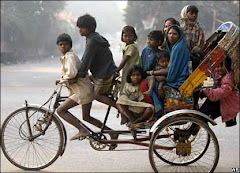India has a long history of social banking. The first breakthrough of the new generation of microfinancing institutions emerged after a change in governmental policy which allowed informal self-help groups (SHG's) of 15-20 members (mainly women) to transact with commercial banks.
Enthusiasm grew with almost missionary zeal among politicians and bankers once they saw the success in repayments and the social impact of the scheme. India is now home to 1.4 million such groups with over 20 million members. Policy and reforms have been extended resulting in the emergence of many MFI's (Microfinancing Institutions) who use various approved methodologies to deliver their service.
Global growth in the formal microfinance sector has increased from 4 billion USD in 2001, to 25 billion USD in 2006, with the Indian sector expected to grow by 20% in the next five years.
Beneficiaries of microfinancing are those lacking collateral and with no verifiable credit history to gain access to traditional credit - mainly the rural poor. So what is the success rate within India for the people that this method of financial assistance was set up to aid?
Minimal in terms of what it could be. The brightest success story lies with the members of the original SHG's. Members borrow from the group to fund a variety of needs, ranging from household emergencies to school fees. As the SHG's prove capable of managing their funds, they then borrow from a local bank to invest in small business or farm activities. Banks typically lend up to four rupees for every rupee in the group fund, charging 11-12% annual interest. This model is the largest and most successful microfinancing program in the world, with similar programs based on the Indian model now evolving in Africa and Southeast Asia. This is but a drop in the ocean in terms of the potential.
Challenges remain within the industry with a mere 5% of India's estimated 350 million people living below the poverty line having access to microfinance. Logistics, poor infrastructure and regional diversity stand out as the most obvious handicap; but other challenges include the need for further reforms to provide an appropriate legal structure for the growth of microfinance organisations. These reforms would provide transparency and accountability, and would further enhance credibility. Another major challenge within the industry is the attraction and retention of professional and committed human resource.
There remains a lot of policy focus on what activities are and are not allowed, and as yet there appears to be not enough operational freedom for banks, financial institutions and organisations for them to design and deliver sustainable progammes.
Microfinance has not as yet moved centre stage for the Indian financial segment. With a more enabling environment and the continued surge in economic growth within India, the delivery of financial services to the poor promises to be an exciting sector to watch.
Memory Speaks in “Marjorie Prime” and “Anna Christie”
-
Helen Shaw reviews “Marjorie Prime,” with June Squibb, Cynthia Nixon, and
Danny Burstein,
1 hour ago























No comments:
Post a Comment